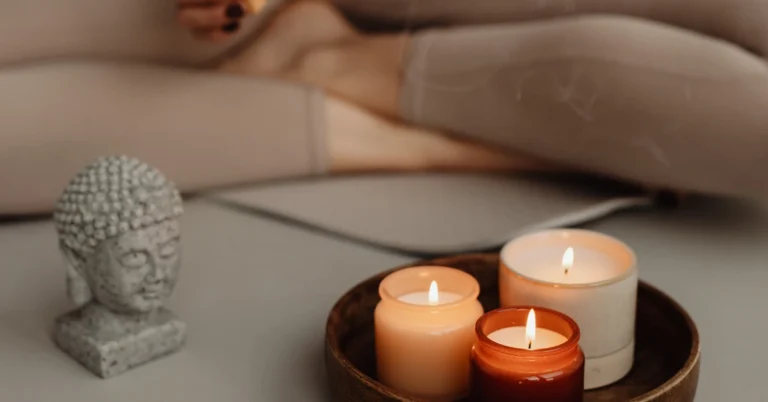Guided meditation is a powerful tool that can help individuals heal emotionally and mentally. Guided meditations for emotional healing are a form of meditation that involves a guide or teacher who leads the meditation session, providing instructions and guidance to participants. Guided meditations for emotional healing can be used for a variety of purposes, including emotional healing, stress reduction, and spiritual growth.
Emotional healing is a process that involves addressing and resolving emotional wounds and traumas. These wounds can be caused by a variety of factors, including past experiences, relationships, and life events. Guided meditations for emotional healing can be an effective tool for emotional healing because it allows individuals to access and process their emotions in a safe and supportive environment. Let us be honest, we all suffer from emotional healing and to me, using guided meditations has helped me with dealing with everything, yet it is still a long way to go.
Healing is a journey. Be gentle with yourself.
Unknown
You want to practice more self care and need a special gift for your beloved ones? With those 50 affirmation cards you are good to go ✨.
Understanding Emotional Healing
Emotional healing is the process of addressing and resolving emotional wounds that have been caused by past experiences. It is a way of releasing negative emotions that have been stored in the body and mind, in order to promote overall wellbeing.
The first step in emotional healing is to acknowledge and accept the emotions that are present. This can be difficult, as many people try to suppress or ignore their emotions. However, it is important to recognize that emotions are a natural part of the human experience, and that it is okay to feel them.
Once you have acknowledged your emotions, the next step is to identify the root cause of them. This may involve exploring past experiences and relationships, and understanding how they have impacted your emotional state. It may also involve seeking support from a therapist or counselor, who can provide guidance and insight into your emotional healing journey.
Guided meditations for emotional healing can be powerful tools in the emotional healing process. By focusing on the present moment and allowing yourself to experience your emotions without judgment, you can begin to release negative energy and promote healing. Guided meditations that focus on self-compassion, forgiveness, and gratitude can be particularly helpful in promoting emotional healing.
It is important to remember that emotional healing is a journey, and that it takes time and effort to achieve. However, by acknowledging and accepting your emotions, identifying their root causes, and utilizing tools like guided meditation, you can begin to promote emotional healing and improve your overall wellbeing.
Why practice guided meditations for emotional healing?
Meditation is a powerful tool that can help us heal emotionally. It allows us to connect with our inner selves and find peace in the present moment. Through meditation, we can learn to observe our thoughts and emotions without judgment, and this can help us gain clarity and perspective on our problems.
One of the key benefits of meditation is that it can help us reduce stress and anxiety. When we meditate, we activate the parasympathetic nervous system, which is responsible for relaxation and rest. By doing so, we can lower our heart rate, blood pressure, and cortisol levels, which are all markers of stress.
Guided meditations for emotional healing can also help us develop greater self-awareness and self-compassion. When we meditate, we learn to observe our thoughts and emotions without getting caught up in them. This can help us develop a more compassionate and non-judgmental attitude towards ourselves, which can be incredibly healing.
I personally think that meditation can help us cultivate a sense of inner peace and happiness. By focusing on the present moment and letting go of our worries and fears, we can experience a deep sense of contentment and joy. This can help us feel more connected to ourselves and to others, which is essential for emotional healing.
Meditation can play a powerful role in emotional healing. It can help us reduce stress and anxiety, develop greater self-awareness and self-compassion, and cultivate a sense of inner peace and happiness. By incorporating meditation into our daily lives, we can learn to connect with our inner selves and find the healing we need.
Preparing for Guided Meditation For Emotional Healing

Before starting a guided meditation for emotional healing, it is essential to prepare yourself. Here are a few things I like to do to prepare myself for a successful meditation session:
Find a Quiet and Comfortable Space
It is crucial to find a quiet and comfortable space where you can meditate without any distractions. You can choose a room in your house or a quiet corner in your garden. Make sure the space is clean, well-ventilated, and has enough natural light.
Wear Comfortable Clothing
Wearing comfortable clothing is essential for a successful meditation session. Choose loose-fitting clothes that do not restrict your movements and allow you to breathe comfortably. Avoid wearing tight clothes or anything that makes you feel uncomfortable.
Set an Intention
Setting an intention before starting guided meditations for emotional healing can help you focus your mind and achieve your goals. You can set an intention to heal emotional wounds, reduce stress, or cultivate inner peace. Whatever your intention, make sure it is positive, specific, and meaningful to you.
Use Props
Using props like cushions, blankets, or yoga blocks can help you sit comfortably and maintain good posture during meditation. You can also use essential oils or candles to create a relaxing atmosphere and enhance your meditation experience.
Turn Off Distractions
Before starting guided meditations for emotional healing, turn off all your electronic devices like phones, laptops, or tablets. You can also ask your family members or roommates not to disturb you during your meditation session.
By following these simple steps, you can prepare yourself for a successful guided meditations for emotional healing. Remember, meditation is a personal practice, and there is no right or wrong way to do it. Trust your intuition, be patient, and enjoy the journey.
Different Techniques in Guided Meditation For Emotional Healing

Breathing Techniques
When it comes to emotional healing, breathing techniques can be very effective. One such technique is called “belly breathing.” To practice this technique, sit or lie down in a comfortable position and place one hand on your belly and the other on your chest. Take a deep breath in through your nose, filling your belly with air, and then slowly exhale through your mouth, pushing all the air out. Repeat this for several minutes, focusing on the sensation of your breath moving in and out of your body.
Another effective breathing technique is called “4-7-8 breathing.” To practice this technique, sit or lie down in a comfortable position and breathe in deeply through your nose for a count of four. Hold your breath for a count of seven, and then exhale slowly through your mouth for a count of eight. Repeat this for several minutes, focusing on the rhythm of your breath and the sensation of your body relaxing.
Visualization Methods
Visualization can also be an effective technique for emotional healing. One such method is called “the safe place visualization.” To practice this technique, close your eyes and imagine a place where you feel completely safe and at peace. It can be a real place or an imaginary one. Visualize the sights, sounds, and smells of this place, and allow yourself to feel the sense of safety and peace that comes with it.
Another visualization technique is called “the release visualization.” To practice this technique, close your eyes and imagine the emotions or thoughts that are causing you distress as a physical object. Visualize yourself holding this object in your hands, and then imagine yourself releasing it into the universe. Visualize it disappearing from your life and feel the sense of relief that comes with letting go.
Body Scan Meditation
Body scan meditation is a technique that involves focusing on different parts of your body and noticing any sensations you feel. To practice this technique, sit or lie down in a comfortable position and close your eyes. Start at the top of your head and slowly scan down your body, noticing any areas of tension or discomfort. As you notice these areas, take a deep breath in and imagine the tension or discomfort melting away with each exhale.
These are just a few of the many guided meditations for emotional healing.
By incorporating these techniques into your daily routine, you can learn to manage your emotions more effectively and find a greater sense of peace and calm in your life.
Incorporating Guided Meditations for Emotional Healing into Daily Routine

As someone who has been practicing guided meditations for emotional healing for a while now, I have found that incorporating it into my daily routine has been extremely beneficial for my mental health. Here are a few ways I have made it a regular part of my day:
Schedule a specific time
I find it helpful to schedule a specific time for my guided meditations for emotional healing every day. For me, this is usually in the morning before I start my workday. By setting aside a specific time, I am more likely to actually do it and less likely to forget.
Find a quiet space
It’s important to find a quiet space where you can relax and focus on your guided meditation. This could be a spare room in your home, a quiet corner of your bedroom, or even outside in nature. Just make sure it’s a space where you feel comfortable and won’t be disturbed.
Use a guided meditation app
There are many guided meditation apps available that can help you incorporate this practice into your daily routine. Personally, I use the Headspace app, which offers a variety of guided meditations for different purposes, including emotional healing.
Start small
If you’re new to guided meditation, it’s important to start small and work your way up. Begin with just a few minutes each day and gradually increase the time as you become more comfortable with the practice.
By incorporating guided meditations for emotional healing into your daily routine, you can experience the many benefits of this practice, including reduced stress and anxiety, improved focus and concentration, and emotional healing.
Overcoming Challenges in Guided Meditation for Emotional Healing

During guided meditations for emotional healing, it is common to encounter challenges that may hinder your progress towards emotional healing. Here are a few challenges that you may face during guided meditation and how to overcome them:
Distractions
Distractions are one of the most common challenges during guided meditations for emotional healing. It’s important to remember that distractions are a natural part of the meditation process. When you notice a distraction, acknowledge it and then gently bring your focus back to your breath or the guided meditation.
Physical Discomfort
Physical discomfort during guided meditations for emotional healing can be a major challenge. If you experience discomfort, try adjusting your posture or finding a more comfortable position. You can also try stretching before your meditation to help alleviate any tension in your body.
Racing Thoughts
Racing thoughts during guided meditations for emotional healing can be a major challenge during guided meditation. When you notice your thoughts racing, try to observe them without judgment and then gently bring your focus back to your breath or the guided meditation. You can also try counting your breaths or repeating a mantra to help quiet your mind.
Impatience
Impatience can be a major challenge during guided meditations for emotional healing, especially if you’re new to the practice. Remember that meditation is a skill that takes time to develop. If you’re feeling impatient, try to observe your feelings without judgment and then gently bring your focus back to your breath or the guided meditation.
By acknowledging and overcoming these challenges, you can deepen your guided meditations for emotional healing practice and experience progress constantly.
Measuring Progress During Guided Meditations for Emotional Healing

As I continue to practice guided meditation for emotional healing, I have found it helpful to measure my progress and track my results. Here are some ways I have found to measure progress in emotional healing through meditation:
Self-Reflection
One way to measure progress in guided meditations for emotional healing is through self-reflection. After each meditation session, I take some time to reflect on how I feel emotionally and mentally. I ask myself questions such as:
- Do I feel more relaxed and calm than before the meditation?
- Have I noticed any changes in my thought patterns or behaviors?
- Am I able to better cope with stress and difficult emotions?
By regularly checking in with myself and reflecting on my progress, I am able to see how my meditation practice is positively impacting my emotional well-being.
Journaling
Another way to measure progress in emotional healing is through journaling. After each meditation session, I write down my thoughts and feelings. I also note any insights or realizations that came up during the meditation. Over time, I can look back at my journal entries and see how my emotional state has changed and evolved. This can be a helpful tool for tracking progress and identifying patterns.
Physical Symptoms
Emotional healing can also manifest in physical symptoms. By paying attention to my body, I can gauge how my meditation practice is impacting my physical health. For example, I may notice that I am sleeping better or experiencing less tension in my muscles. By tracking these physical changes, I can see how my emotional healing is positively impacting my overall well-being.
Measuring progress in emotional healing through meditation can be a helpful tool for staying motivated and tracking results. By using self-reflection, journaling, and paying attention to physical symptoms, I am able to see how my meditation practice is positively impacting my emotional well-being.
Other Options for Emotional Healing

When it comes to emotional healing, there are many options available that can be helpful in conjunction with guided meditation. Here are a few options to consider:
Therapy
Therapy can be an effective way to work through emotional issues and develop coping skills. A licensed therapist can provide a safe and supportive environment to explore your emotions and develop strategies for managing them. There are many different types of therapy available, so it’s important to find one that works best for you.
Self-Help Books
Self-help books can be a valuable resource for those looking to work on their emotional well-being. There are many books available on topics such as mindfulness, self-compassion, and emotional regulation. Look for books that are evidence-based and written by reputable authors.
Support Groups
Support groups can provide a sense of community and belonging for those struggling with emotional issues. There are support groups available for a variety of issues, including anxiety, depression, and trauma. Look for groups that are led by trained facilitators and provide a safe and supportive environment.
Mindfulness Apps
There are many mindfulness apps available that can be helpful in developing a regular meditation practice. Apps such as Headspace and Calm offer guided meditations and other mindfulness exercises that can help reduce stress and improve emotional well-being.
Yoga
Yoga is a mind-body practice that can be helpful in reducing stress and improving emotional well-being. Many yoga classes incorporate mindfulness and meditation practices, making it a great complement to guided meditation.
Remember, emotional healing is a process and there is no one-size-fits-all solution. It’s important to find what works best for you and to be patient and compassionate with yourself as you work through your emotions. Have fun exploring guided meditations for emotional healing ✨.
FAQ
What are some effective guided meditations for emotional healing?
There are many effective guided meditations for emotional healing. Some popular ones include body scan meditations, loving-kindness meditations, and mindfulness meditations. It’s important to find a meditation that resonates with you and your specific emotional needs.
What are some effective guided meditations for emotional healing?
There are many effective guided meditations for emotional healing. Some popular ones include body scan meditations, loving-kindness meditations, and mindfulness meditations. It’s important to find a meditation that resonates with you and your specific emotional needs.
Can meditation help with processing emotions?
Yes, meditation can be a powerful tool for processing emotions. By bringing awareness to our thoughts and feelings, we can observe them without judgment and develop a greater sense of emotional intelligence. This can lead to more effective ways of managing and processing our emotions.
How do guided meditations for emotional healing help with healing trauma?
Meditation can help with healing trauma by providing a safe and supportive space to process difficult emotions and memories. By developing a greater sense of self-awareness and self-compassion, we can begin to heal from past traumas and move towards a more positive future.
What are some self-hypnosis techniques for emotional healing?
Self-hypnosis techniques for emotional healing include visualization, positive affirmations, and deep breathing exercises. These techniques can help to reprogram our subconscious mind and promote positive change.
After exploring the serene depths of Guided Meditations for Emotional Healing, we’d love to hear your thoughts and experiences. Share your insights with us in the comments below!






